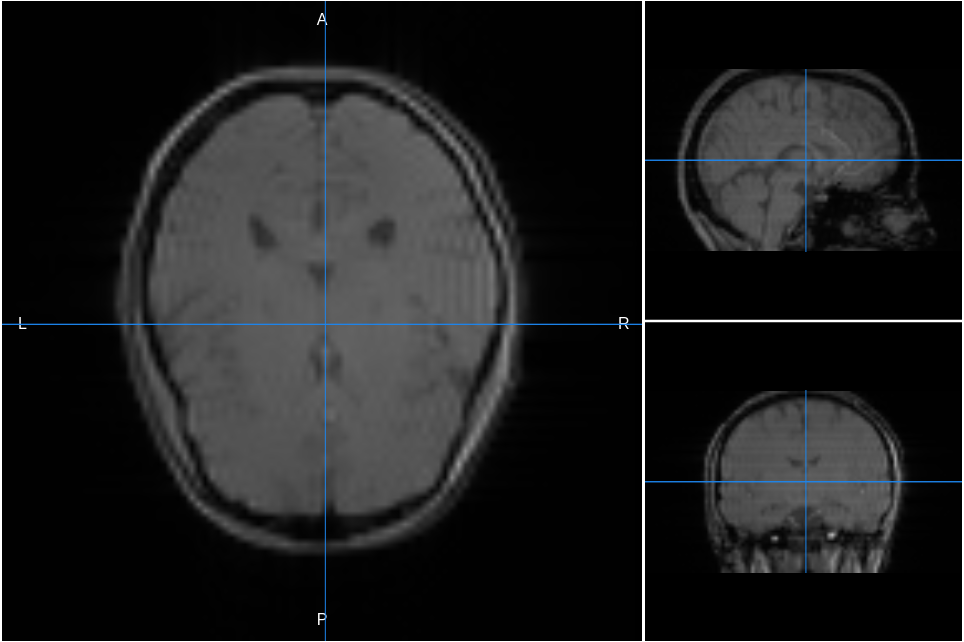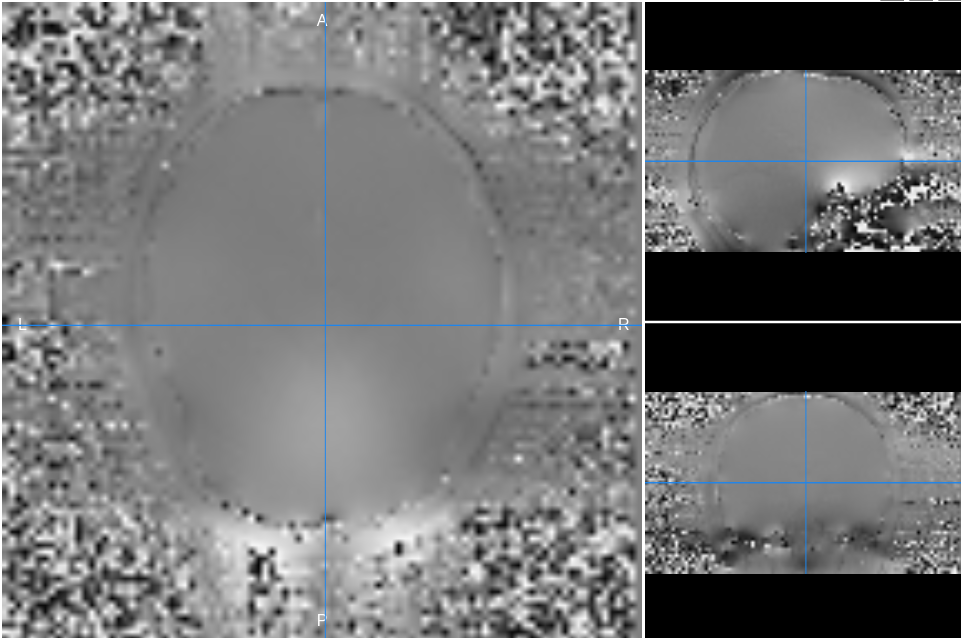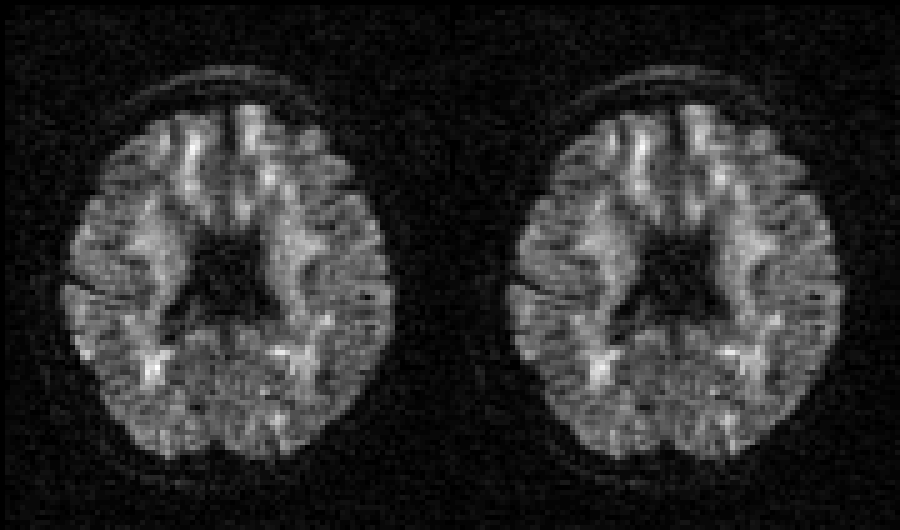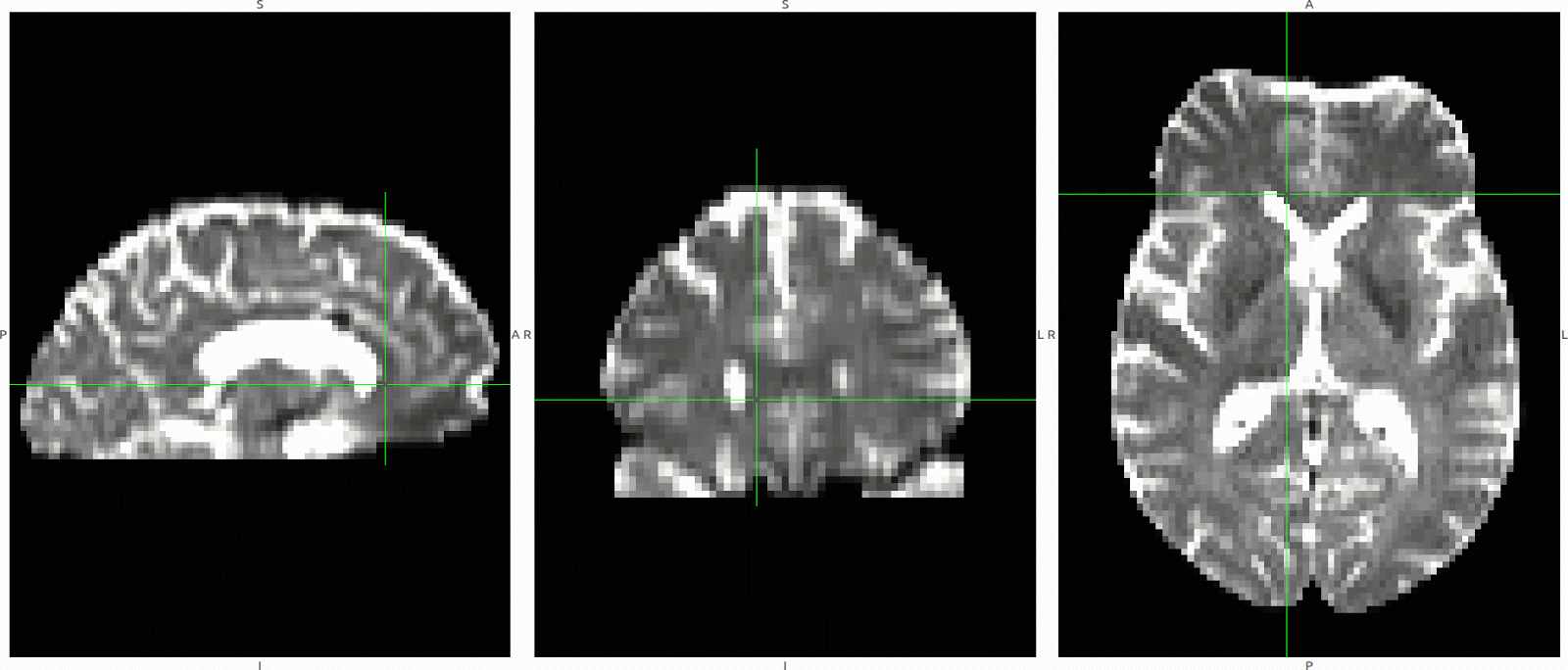dMRI pre-processing
Processes diffusion MRI images to improve the quality of subsequent analysis. The pipeline includes:
- Correction for potential gradient vector flips or misalignments.
- Subject motion correction and Eddy current correction.
- Susceptibility-induced distortion correction (appropriate gradient fieldmaps [GFMs] required).
- Isotropic resolution resampling.
- AC-PC alignment.
- Skull-stripping
Gradient field maps - magnitude/phase pair

Eddy correction - left: uncorrected, right: corrected
Image from FSL-Eddy site
Distortion correction
Required inputs:
- dMRI: diffusion 4D image (DTI or HARDI).
Isotropic resolution recommended.
Must be labeled as 'DTI' or 'HARDI' modality. - Gradients: gradient table (optional if dMRI is DICOM).
MRtrix format supported: file must have '.b' extension and be labeled as 'gradient_table'.
FSL format supported: files must have '.bvec' and '.bval' extensions and be labeled 'bvec' and 'bval'.
Optional inputs:
- GFMs: Gradient field-maps, recommended (magnitude image and phase image).
Same resolution and FOV as dMRI image recommended.
Files must be labeled 'gfm_magnitude' and 'gfm_phase' respectively.
Files must additionally be labeled 'dti' or 'hardi' depending on dMRI modality label.
Minimum input requirements:
- Image must contain full brain DWI dataset.
- For optimal result reliability, dMRI isotropic resolution is highly recommended
- Recommended resolution: 2 mm isotropic.
- Minimum reliable resolution: 3 mm isotropic.
- If DTI image must have at least 7 volumes (1 b0 and 6 diffusion volumes).
- If HARDI image must have at least 21 volumes (1 b0 and 20 diffusion volumes).
- For optimal preprocessing reliability, 1 b0 image is recommended every 10 gradient volumes.
Settings:
- DICOM conversion
- Preferred DICOM to NIfTI conversion tool (drop-down selection)
The selected tool will be tried first to convert DICOM to NIfTI. If the conversion fails, the other options will be tried sequentially until a successful conversion.- MRtrix (Default)
- bru2nii
- DCM2nii
- mcverter
- diffunpack
- Preferred DICOM to NIfTI conversion tool (drop-down selection)
- dMRI pre-processing
The following information about the sequence protocol is required for optimal pre-processing. If 'Use manual diffusion acquisition parameters' is not checked, we will try to retrieve them from the DICOM header. We only provide this service for Siemens and Philips vendors. If unable to recover the true acquisition settings, we will continue with the following default settings: Echo spacing = 0.0003 s; Echo factor = 100; Acceleration factor = 1. They will work well on most datasets.
Echo Spacing (s): The time between echoes in an echo planar image (EPI).
Echo Factor: also called Echo Train Length (ETL), the number of echoes acquired in a single repetition time (TR),
Acceleration factor: the number of EPI lines acquired in parallel.
Echo Difference (s): (only needed if GFMs are provided), the difference in Echo Time (ET) between GFM acquisitions. Default value is typical for SIEMENS scanners.- Skip pre-processing (checkbox)
If checked uses the parameters input manually in the followin - Use manual diffusion acquisition parameters (checkbox)
If checked uses the parameters input manually in the following settings (Default unchecked). - Echo Spacing (s) (float)
(Default 0.3 ms) - Echo Factor (integer)
(Default 100) - Acceleration Factor (integer)
(Default 1) - Echo Difference (s) (float)
(Default 2.46 ms) - dMRI isotropic resampling resolution (mm) (float)
Resamples the dMRI image to the indicated isotropic resolution in mm. (Default 2 mm
- Skip pre-processing (checkbox)
- Alignment
- Do ACPC alignment (checkbox)If checked do ACPC alignment (Default checked)
- Select tool for ACPC alignment (drop-down selection)
- ANTs (default)
- FSL
- Isotropic resampling
- dMRI resampling resolution (mm) (float)
- Resamples the dMRI image to the indicated isotropic resolution in mm.
- dMRI resampling resolution (mm) (float)
- Skull-stripping
- Skull-stripping tool (drop-down selection)
- MRtrix (Default)
- AFNI
- BET
- Additional skull-stripping parameters (string)
String with additional command parameters for the skull stripping tool. Optional (Default empty).
- Skull-stripping tool (drop-down selection)
Outputs:
- Report:
- report.pdf: report file with results summary.
- Images:
- DWI.nii.gz: input dMRI image.
- DWI_eddy_corr.nii.gz: motion + Eddy corrected dMRI image.
- DWI_corr.nii.gz: fully corrected dMRI image (including distortion corrected if selected).
- DWI_resampled_acpc.nii.gz: final corrected, resampled and aligned dMRI image
- gradient_table_corr_acpc.b: gradient table corrected for AC-PC alignment and Eddy correction.
- average_b0s.nii.gz: b0 images extracted and averaged.
Typical execution time:
- 20 - 30 minutes for standard acquisitions (e.g. 2-2.5 mm isotropic 30-60 directions).
Create free account now!
References:
- MRtrix tools: Tournier et al. 2012
- FSL tools: Smith et al. 2004
- Gradient correction: Jeurissen et al. 2014
- Subject motion & Eddy correction: Andersson and Sotiropoulos 2016
- Distortion correction: Jezzard and Balaban 1995 .
- dMRI Skull-stripping:
- MRtrix: Dhollander et al. 2016
- BET: Smith et al. 2002
- AFNI: Cox 1996
- ANTs registration: Avants et al. 2008
- FSL EPI-REG registration: [Greve and Fischl, 2009]
- MNI152 template: Grabner et al. 2006
